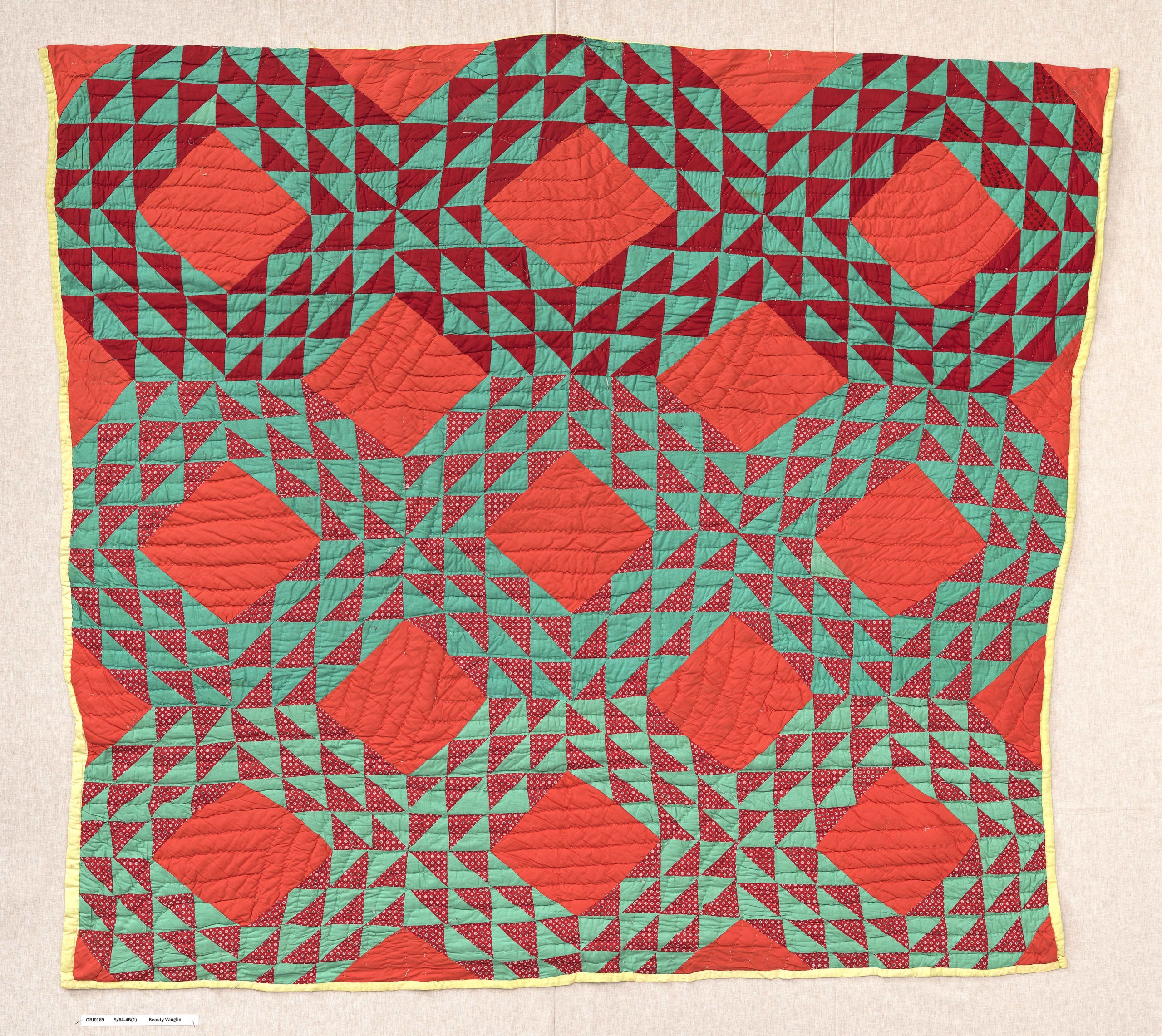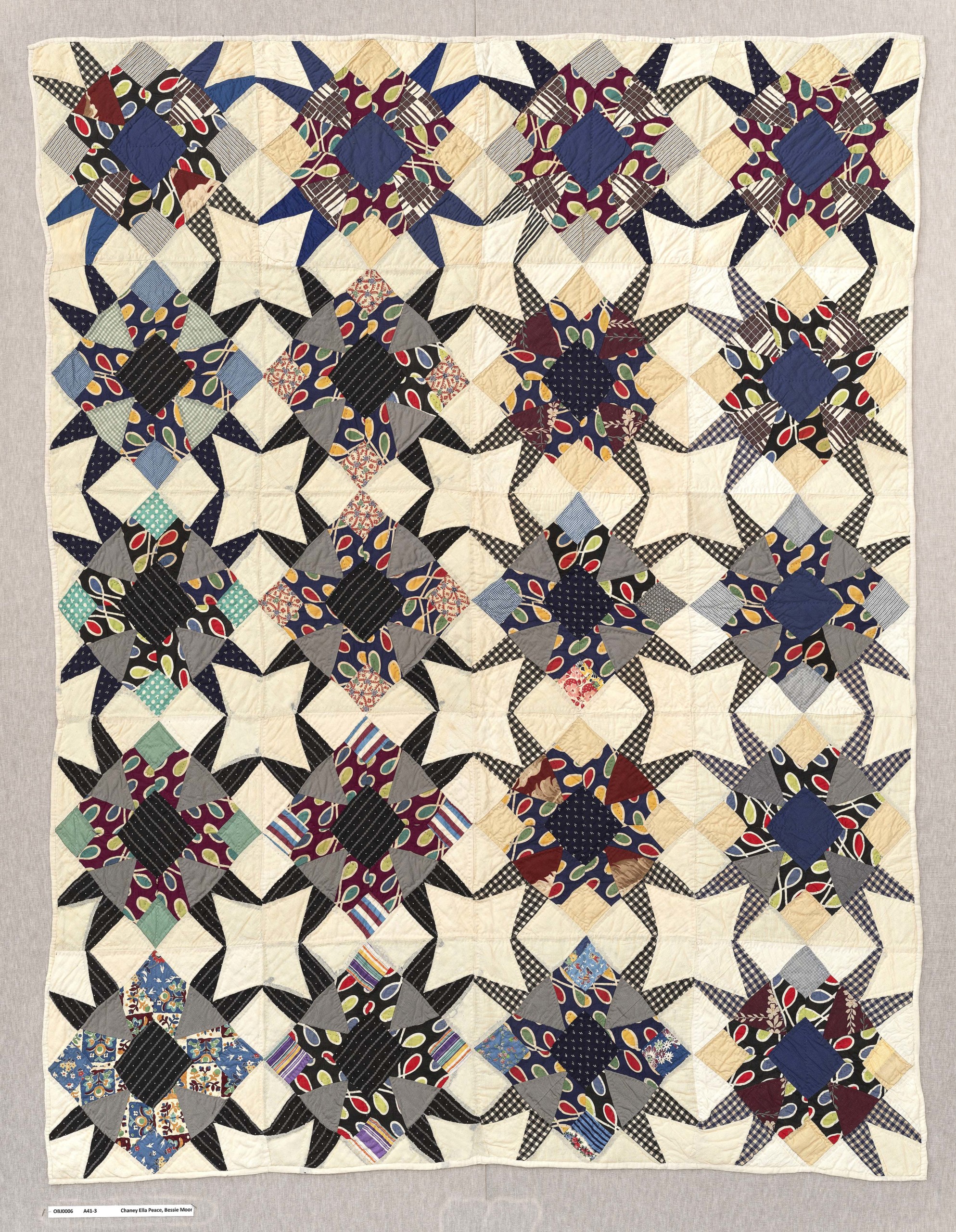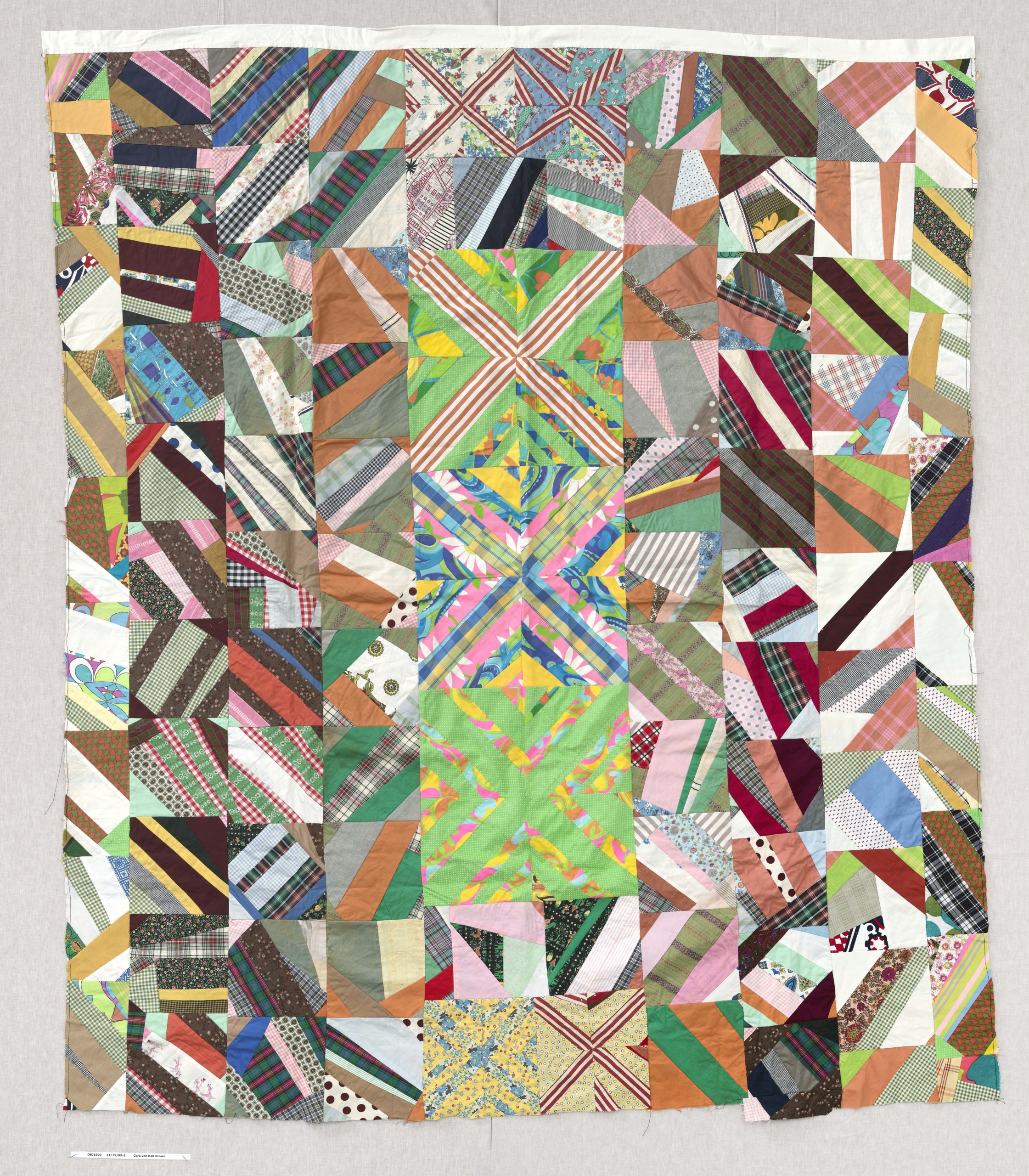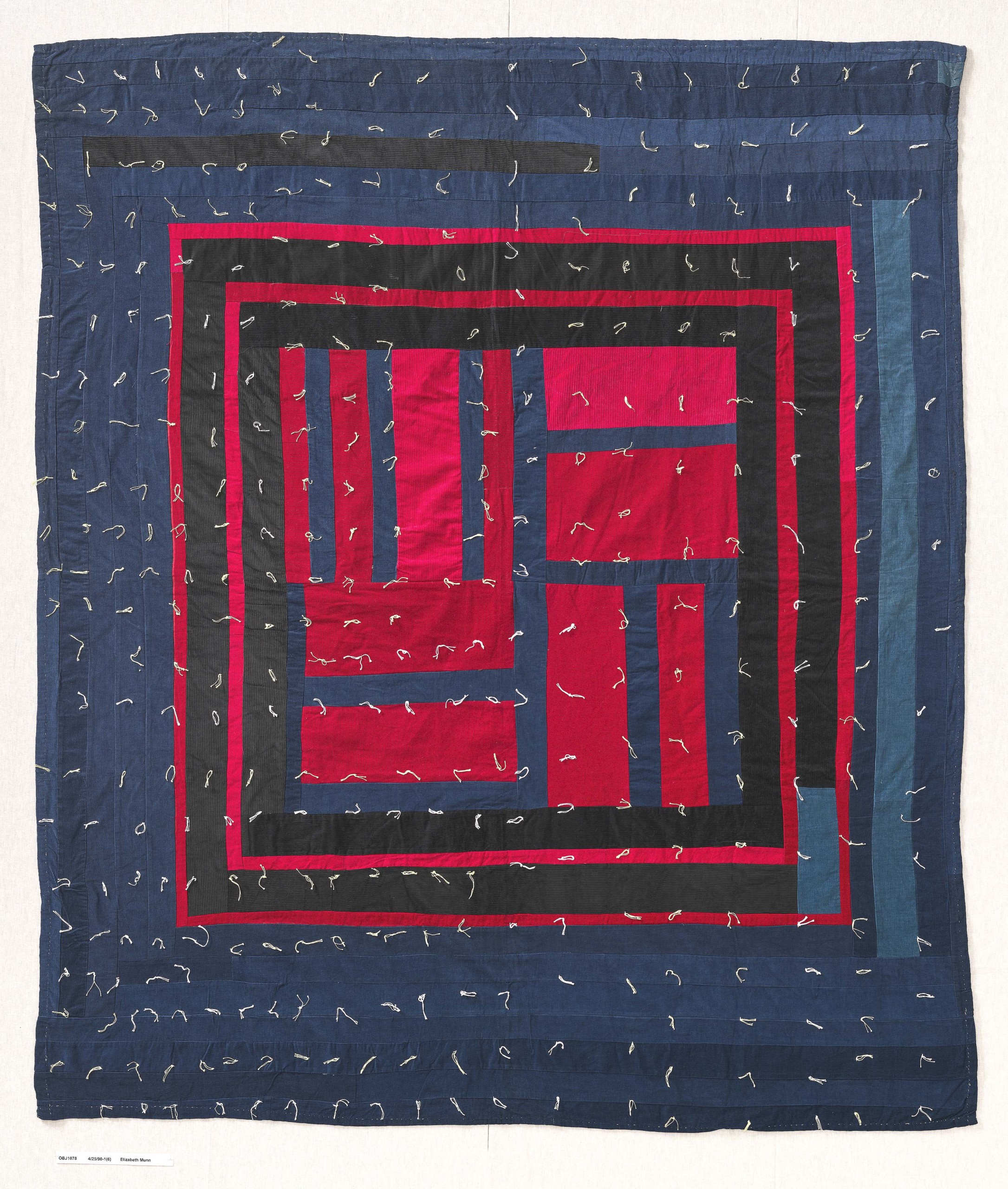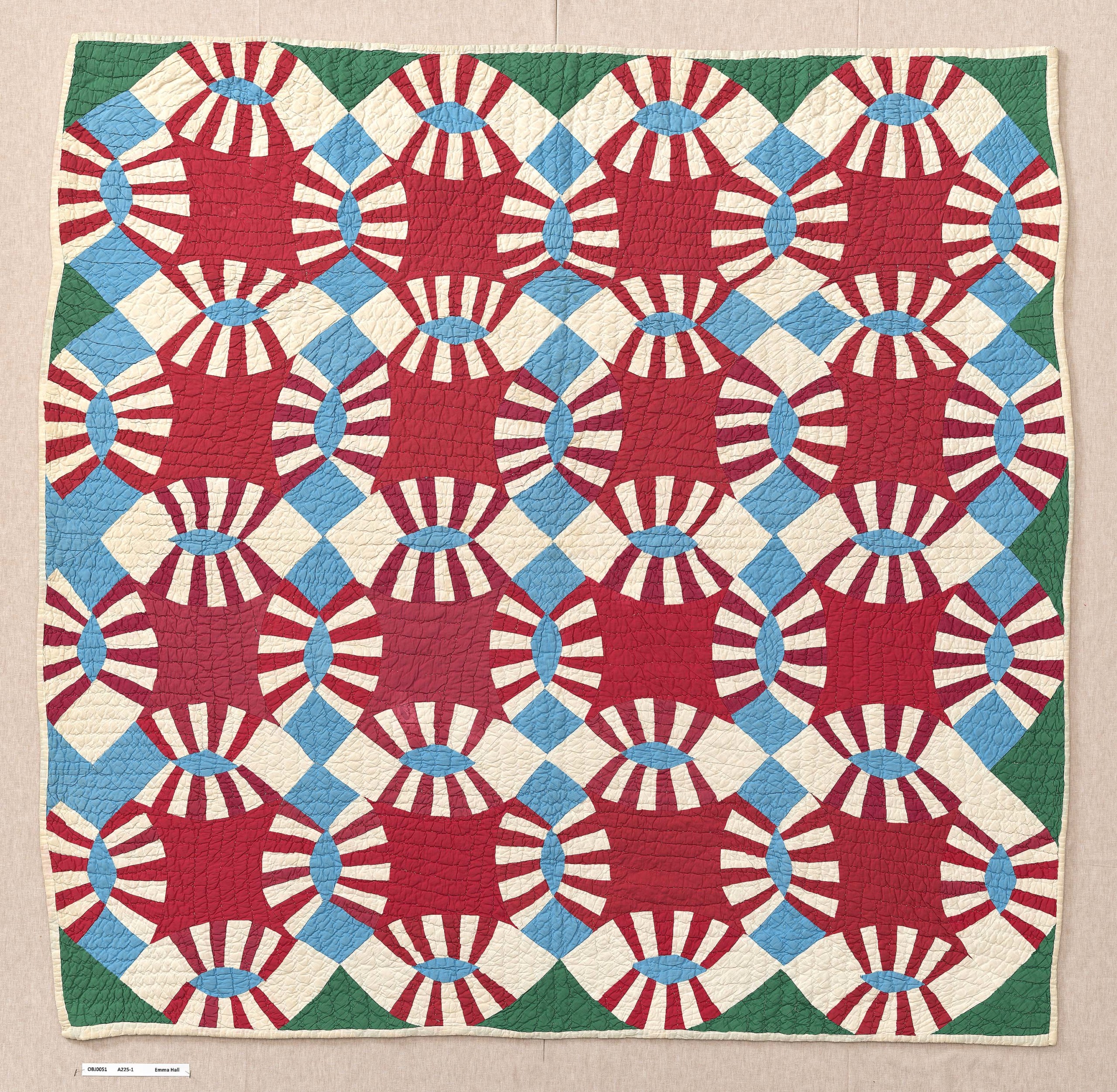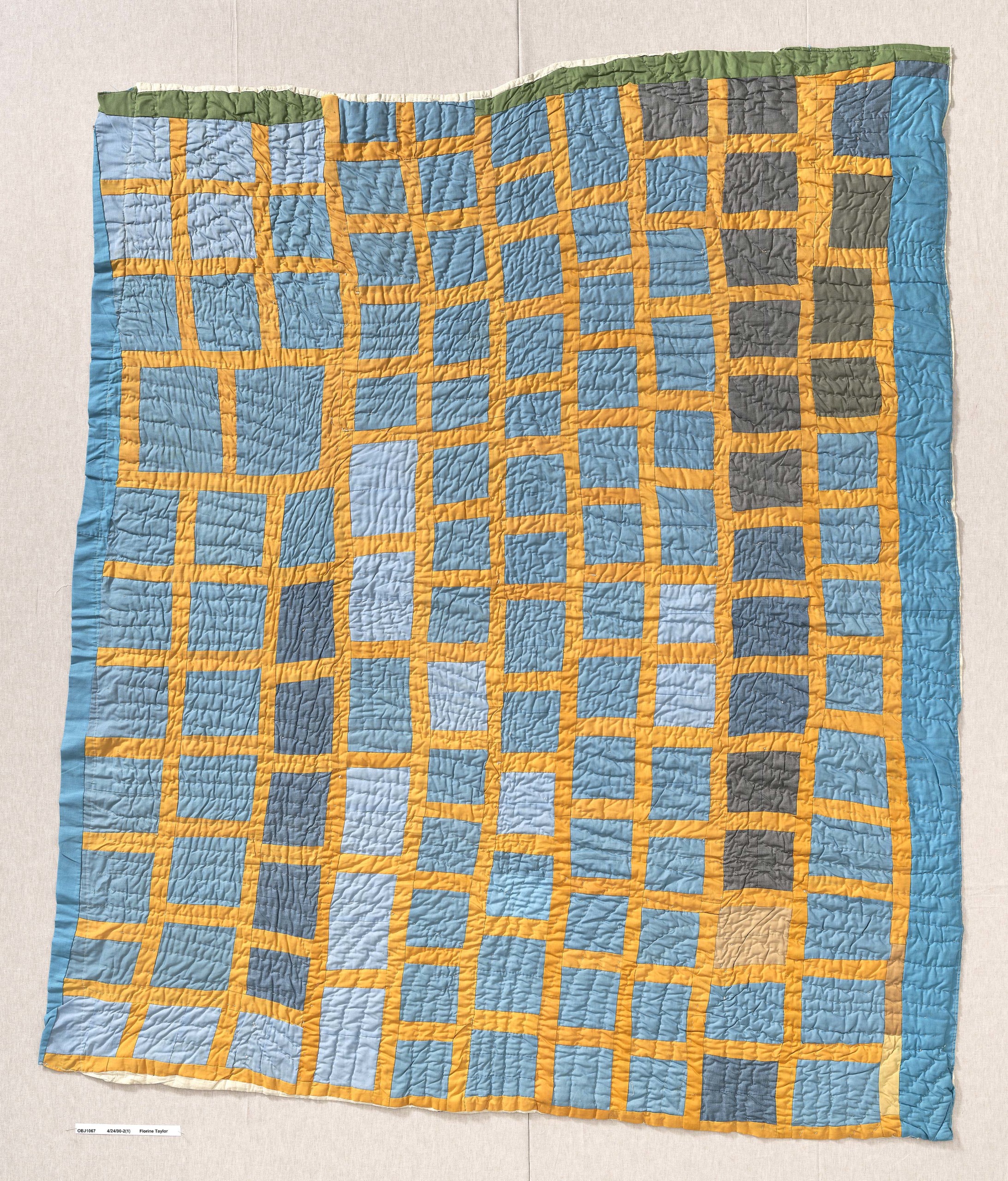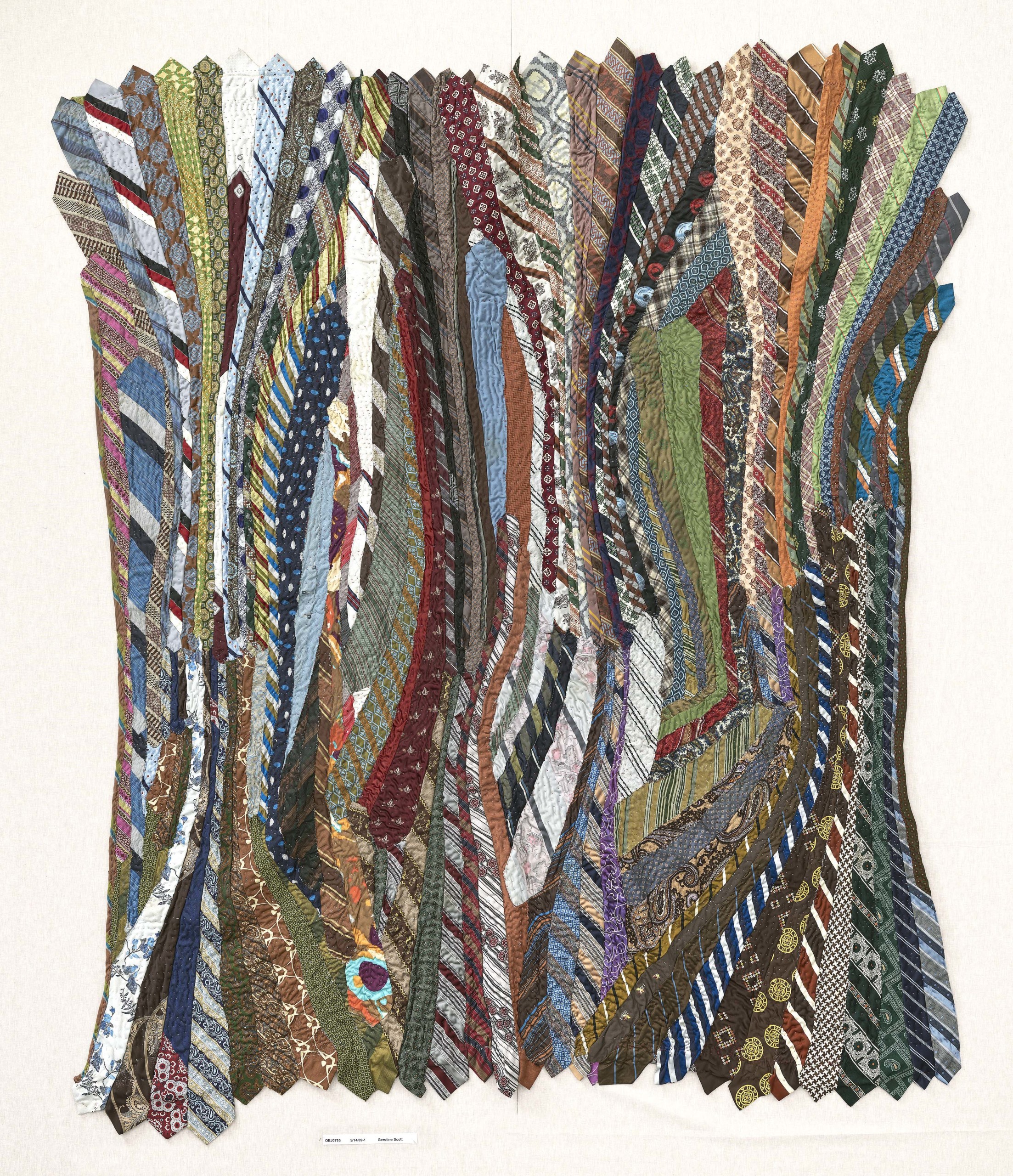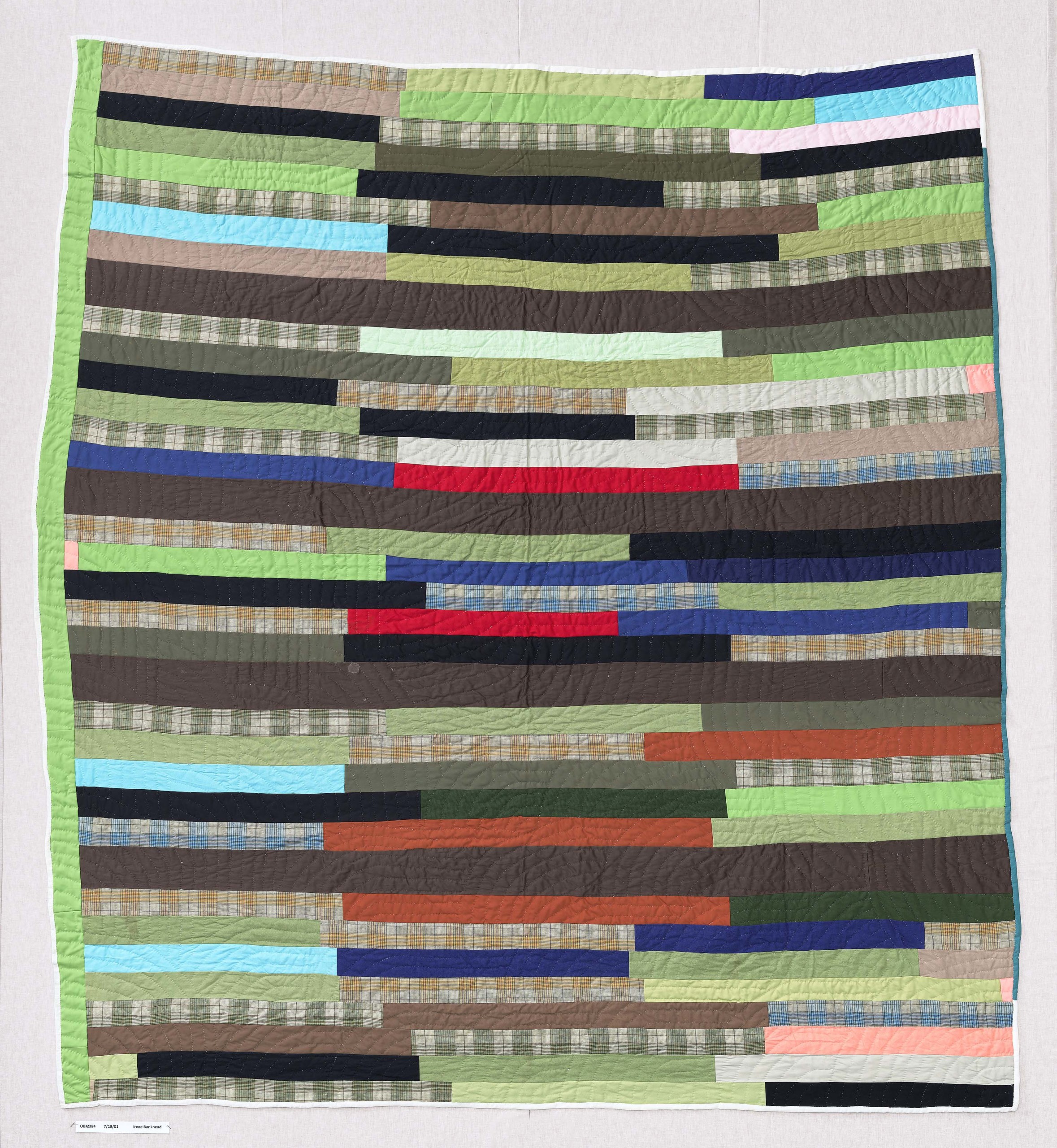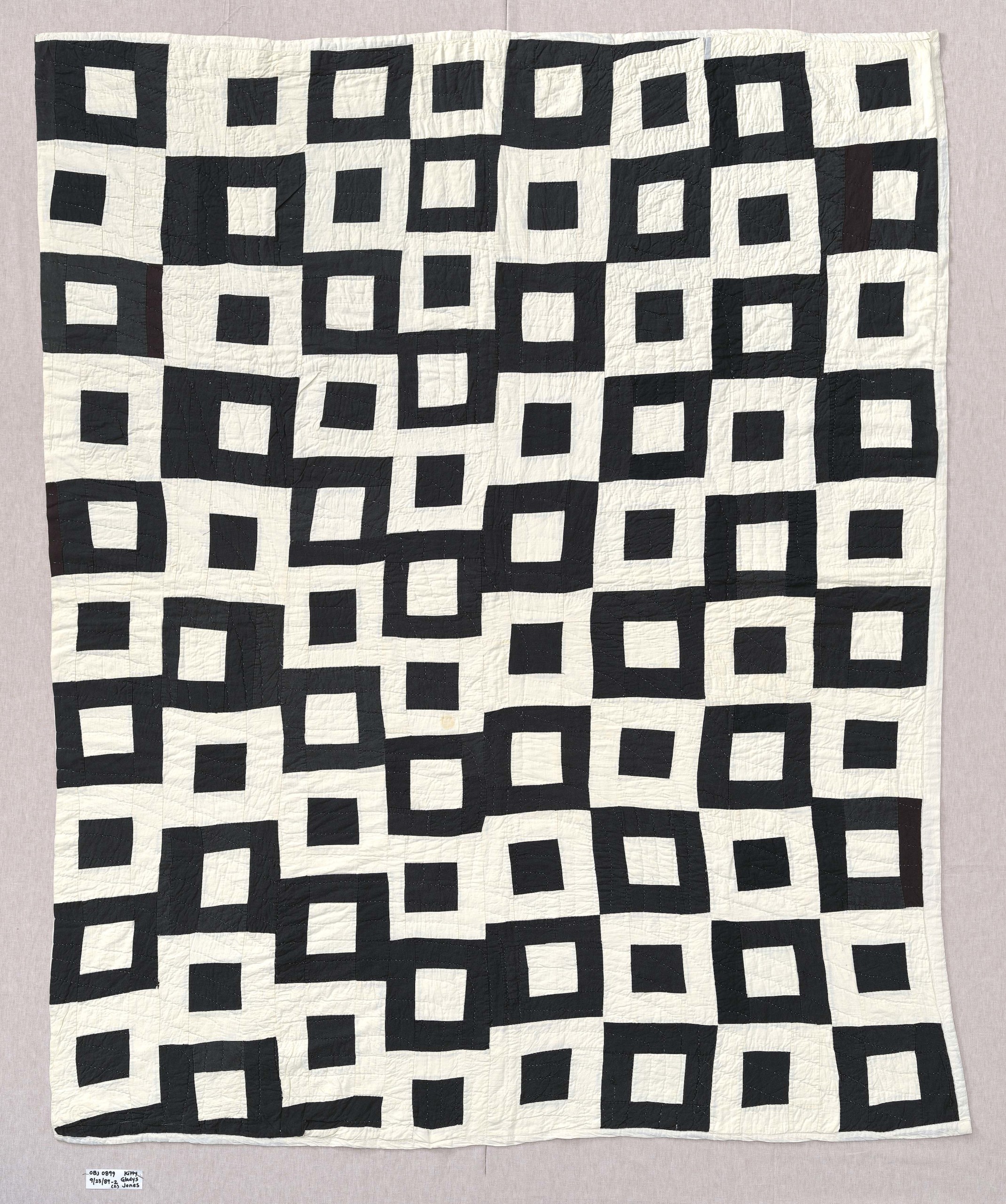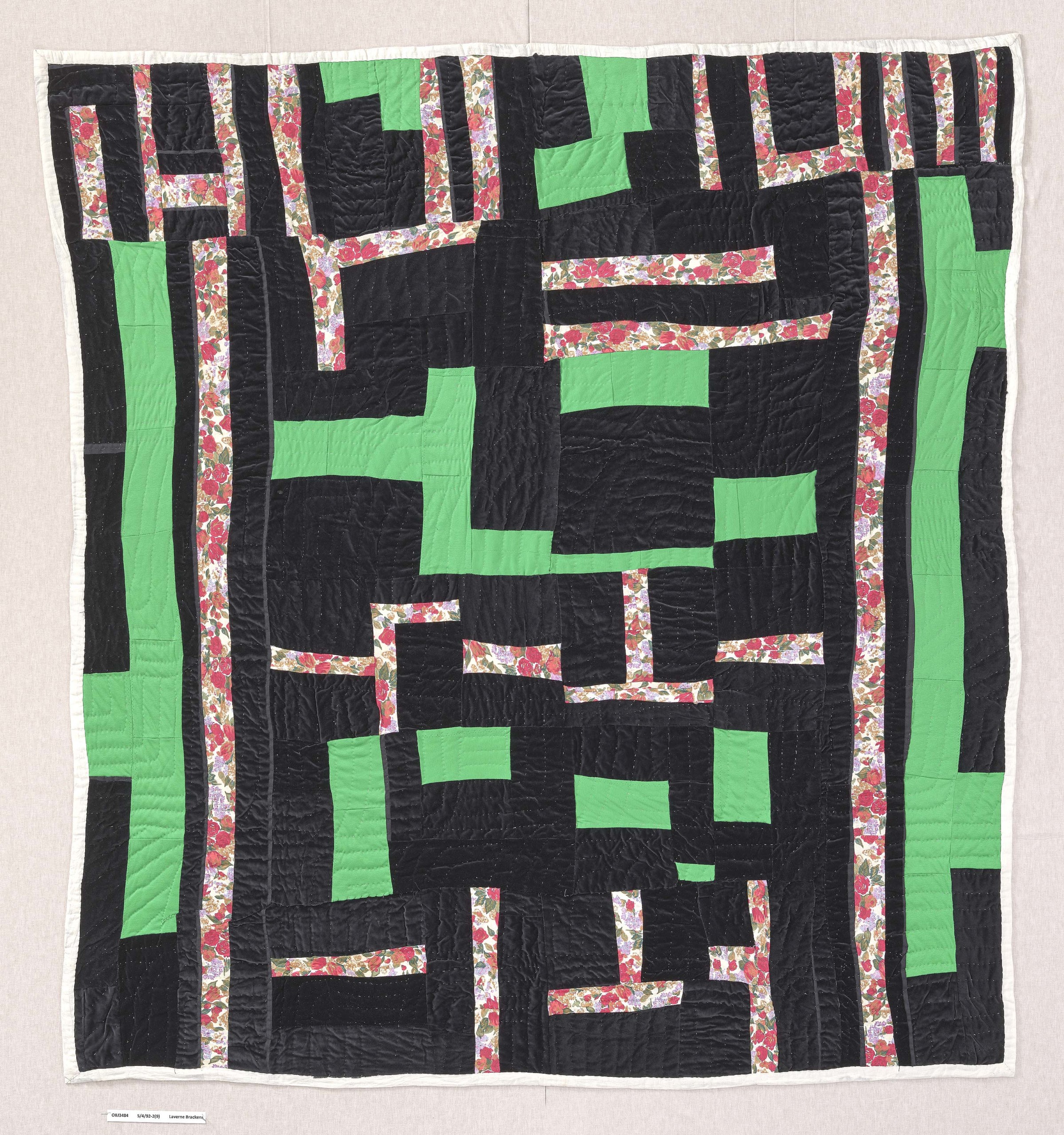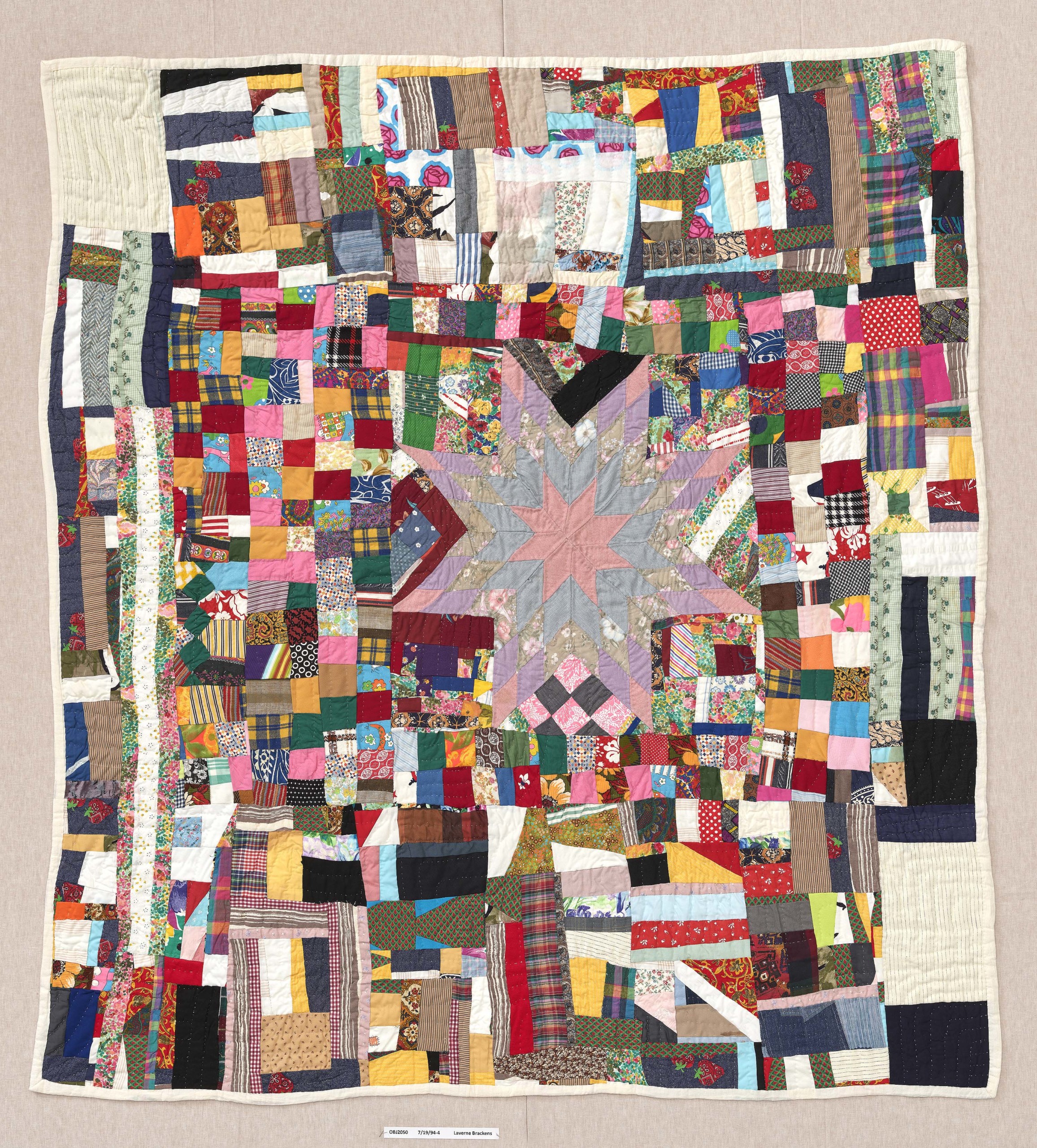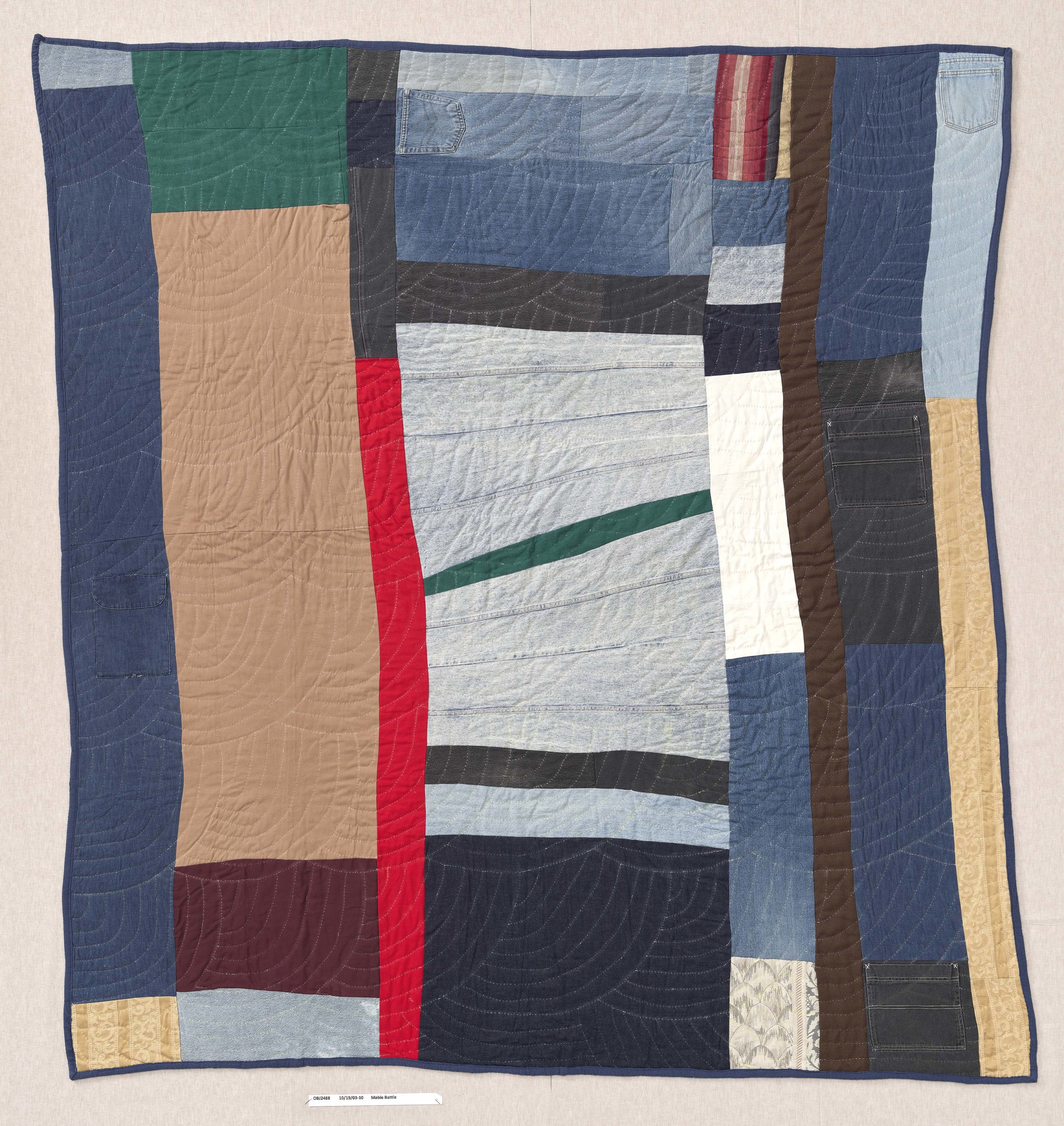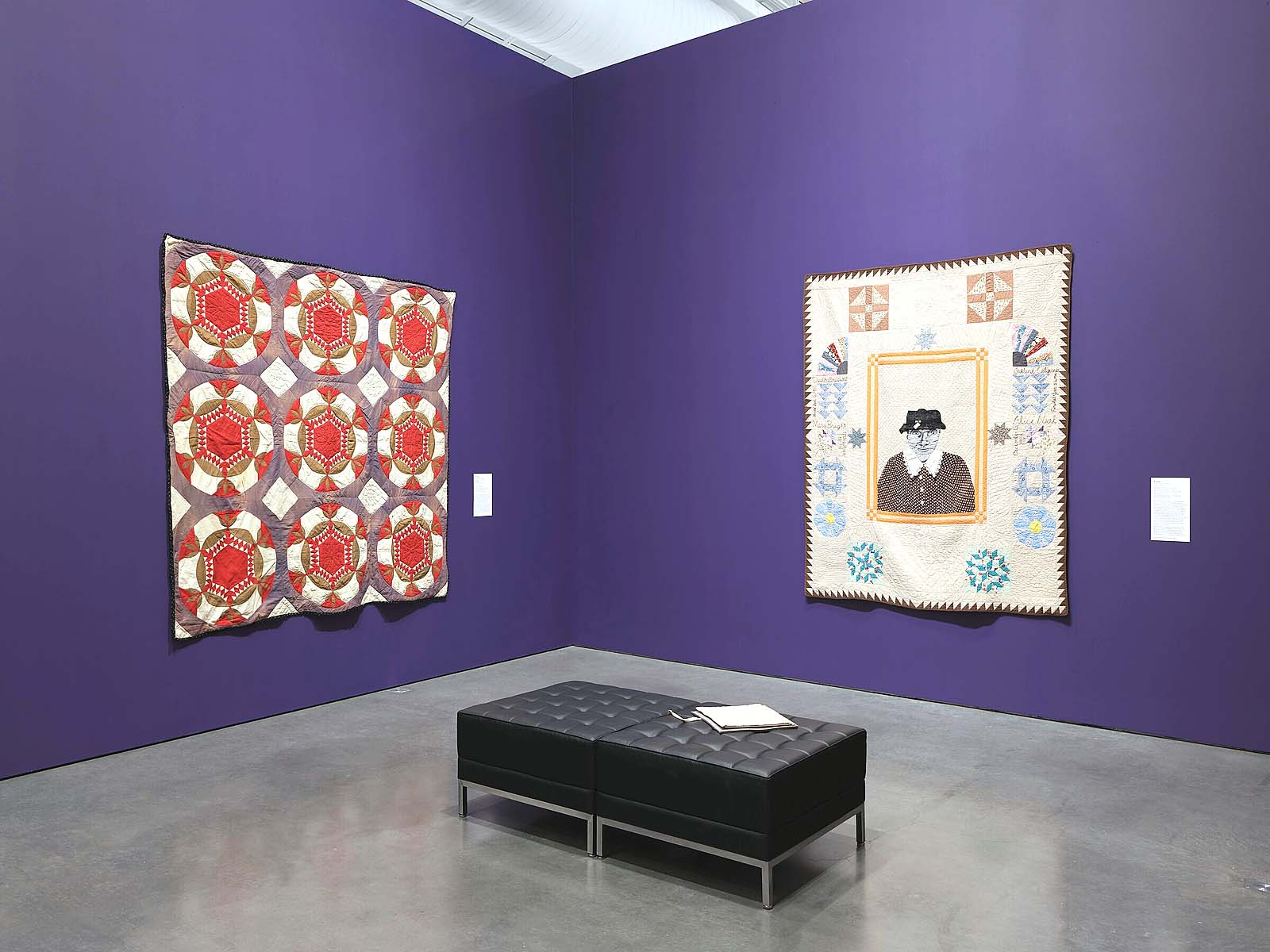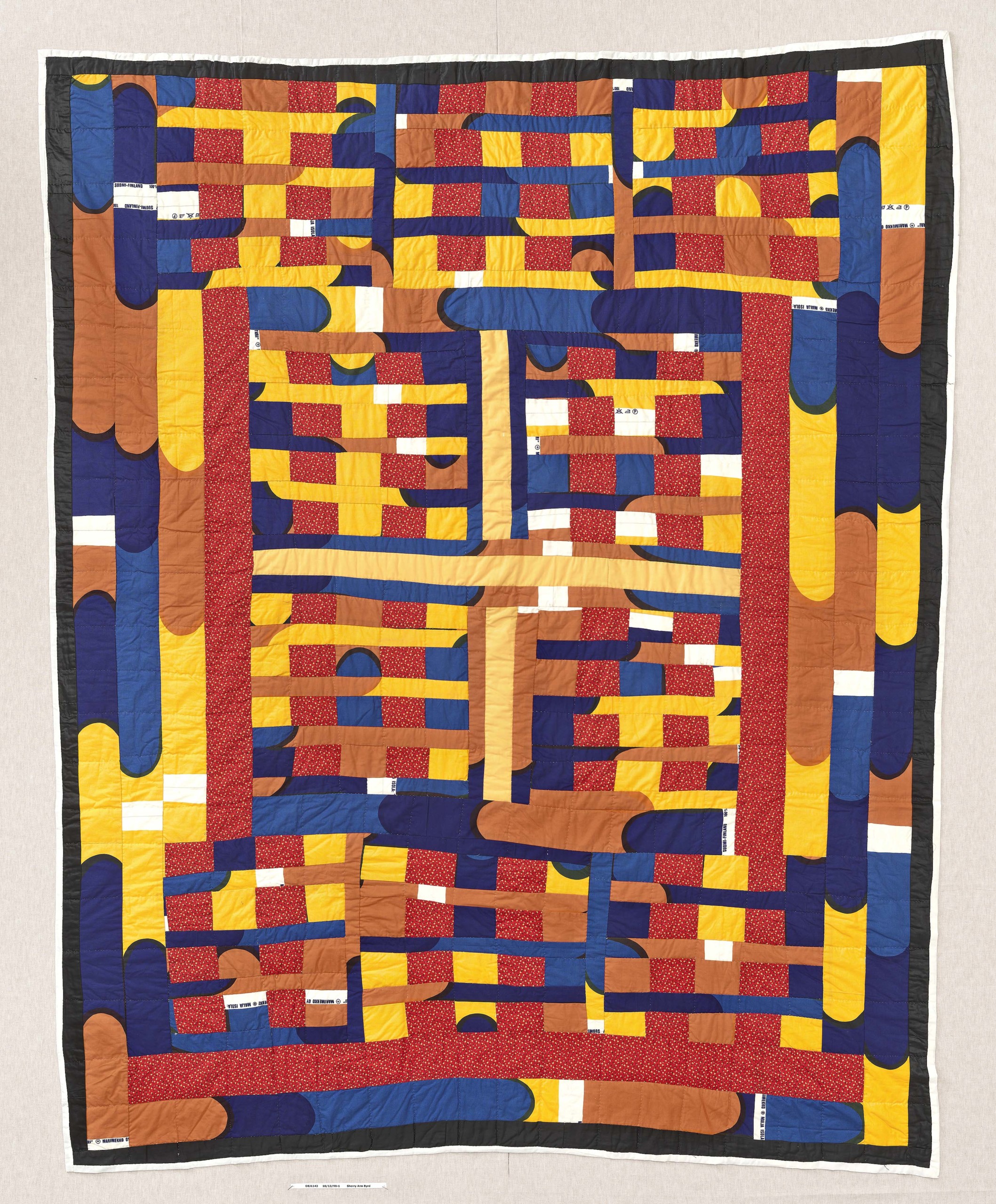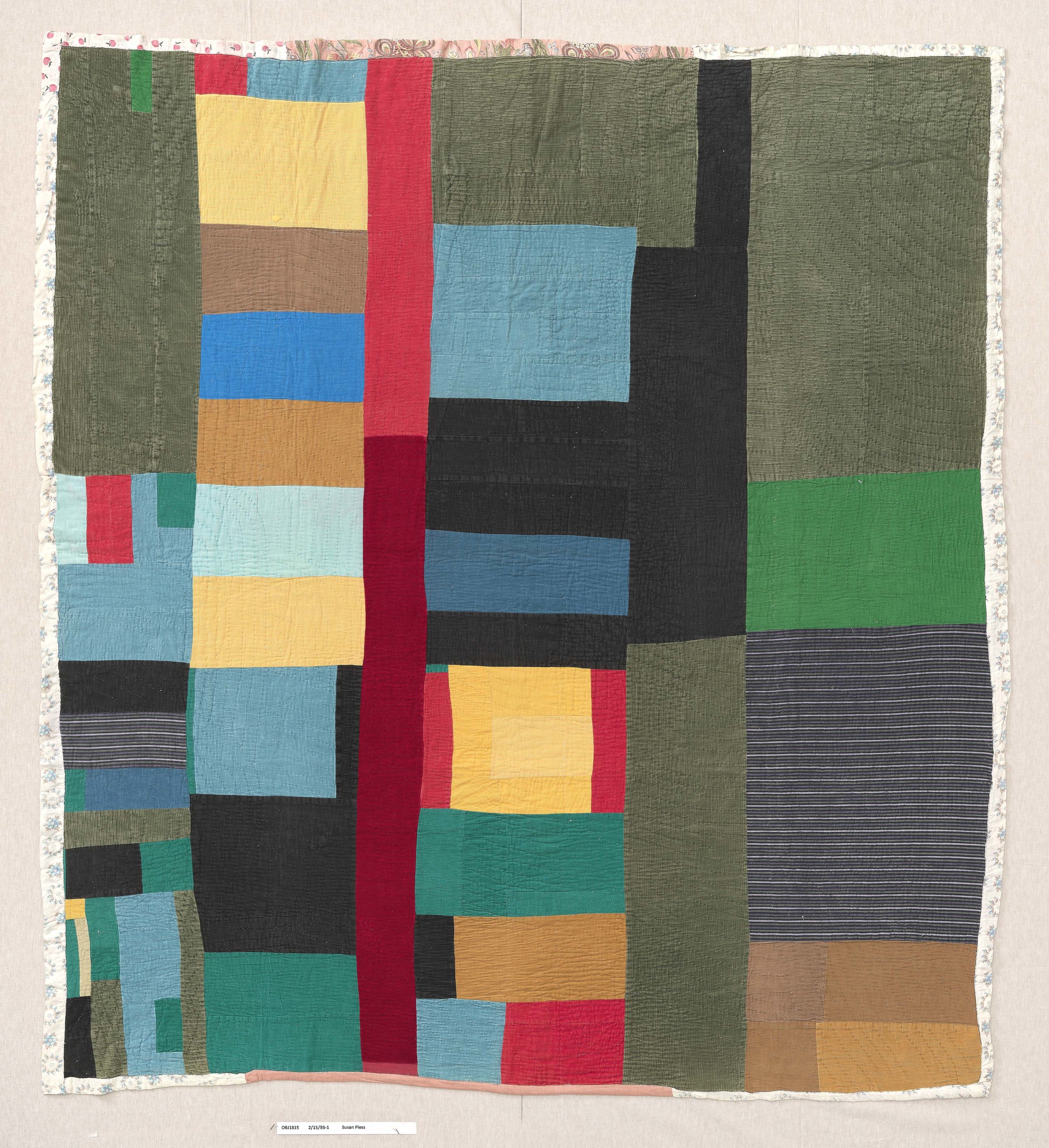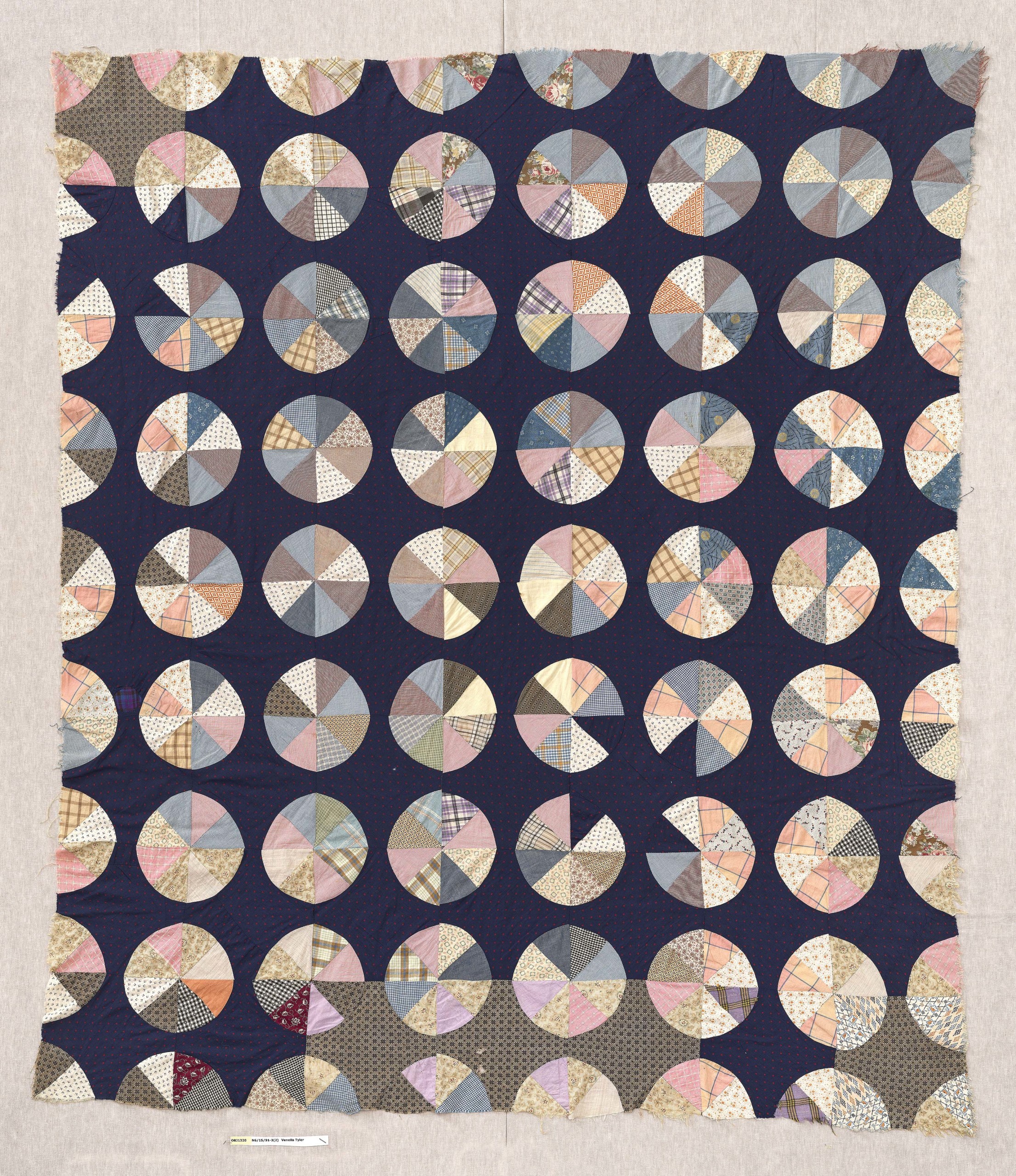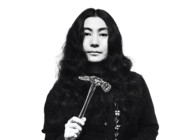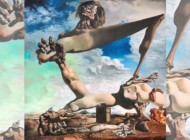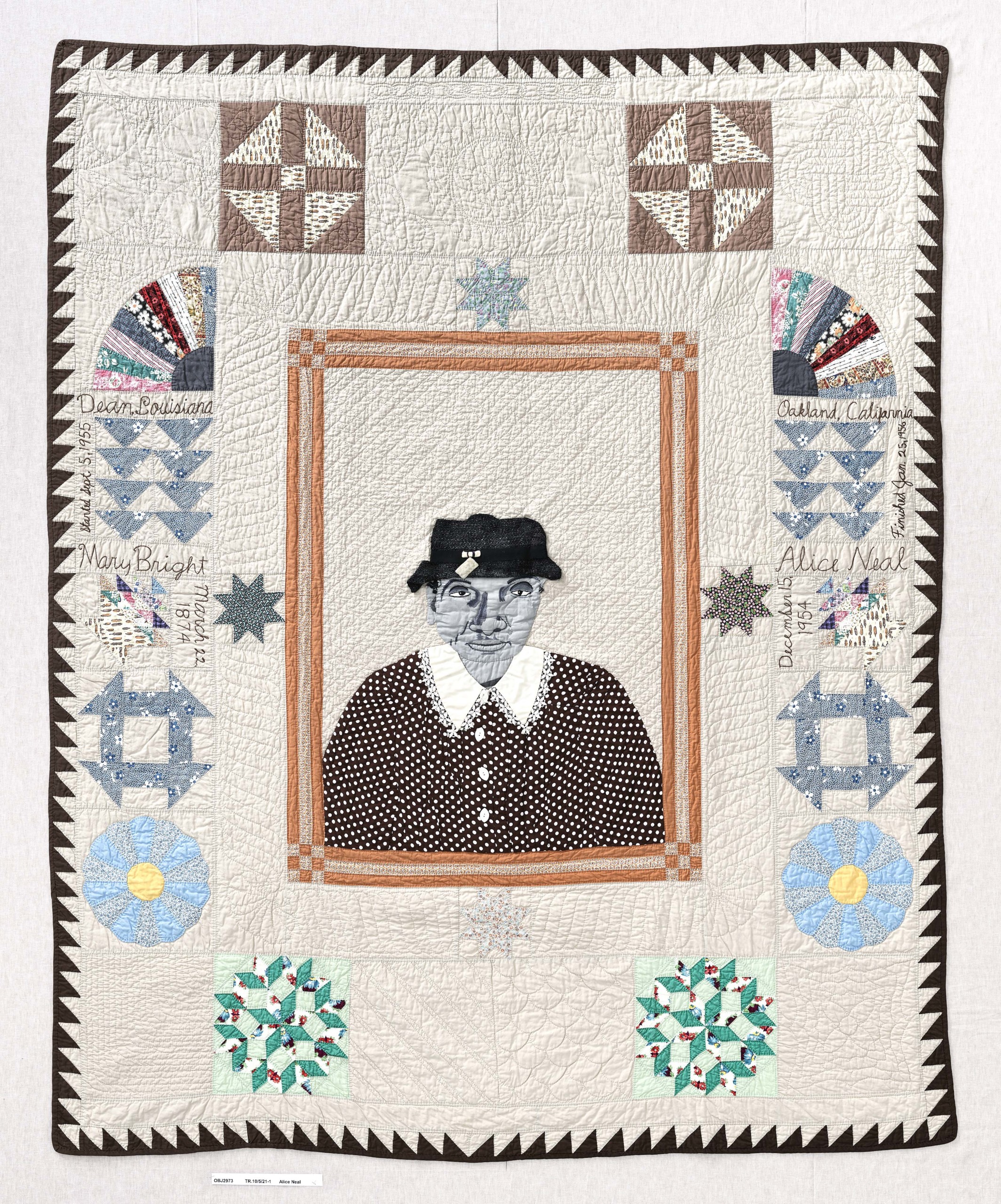
“Mary Bright Commemorative Quilt” (with Dresden Plate, Monkey Wrench, Wild Goose Chase, Fan, Basket of Flowers, Star of Lemoyne patterns and Nine Patch blocks) by Alice Neal, Oakland, Calif., 1955-56, cotton, buttons, woven hat; appliqué, hand pieced, hand quilted, 78½ by 62¾ inches. Bequest of the Eli Leon Living Trust, BAMPFA, OBJ2973. Kevin Candland photo.
By Madelia Hickman Ring
BERKELEY, CALIF. — African American quilts — both contemporary and earlier examples — have been the subject of a few recent landmark exhibitions, including “We Gather at the Edge: Contemporary Quilts by Black Women Artists” (Renwick Gallery Washington, DC, 2025); “Of Salt & Spirit: Black Quilters in the American South” (Mississippi Museum of Art, Jackson, Miss., 2024-25); “Patterns in Abstraction: Black Quilts from the High Collection” (High Museum, Atlanta, 2024-25); “Black Pioneers: Legacy in the American West” (James Museum, St Petersburg, Fla., 2022-23); “Afrofuturism & Quilts: Materializing Black Futures & Black Womxn’s Quilt Legacies” (MSU Museum, East Lansing, Mich., 2024); and “And Still We Rise: African American Story Quilts” (Museum of the Shenandoah Valley, Winchester, Va., 2016). Other shows focused specifically on individual or groups of quilters, such as Faith Ringgold, Rosie Lee Tompkins and the Gee’s Bend (Ala.) quilters.
Breaking new ground in the scholarship of the discipline is “Routed West: Twentieth Century African American Quilts in California,” at the Berkeley Art Museum and Pacific Film Archive (BAMPFA), on the campus of the University of California, Berkeley. Featuring more than 100 quilts by approximately 80 artists, the show builds on an enormous bequest of African American quilts the museum received from the estate of Eli Leon in 2019. It explores the relationship between quilt-making traditions and the history of Black migration to California during the period from 1940 to 1970, when hundreds of thousands of African Americans left the American South for California, looking for greater economic opportunities and to escape the region’s racial violence.
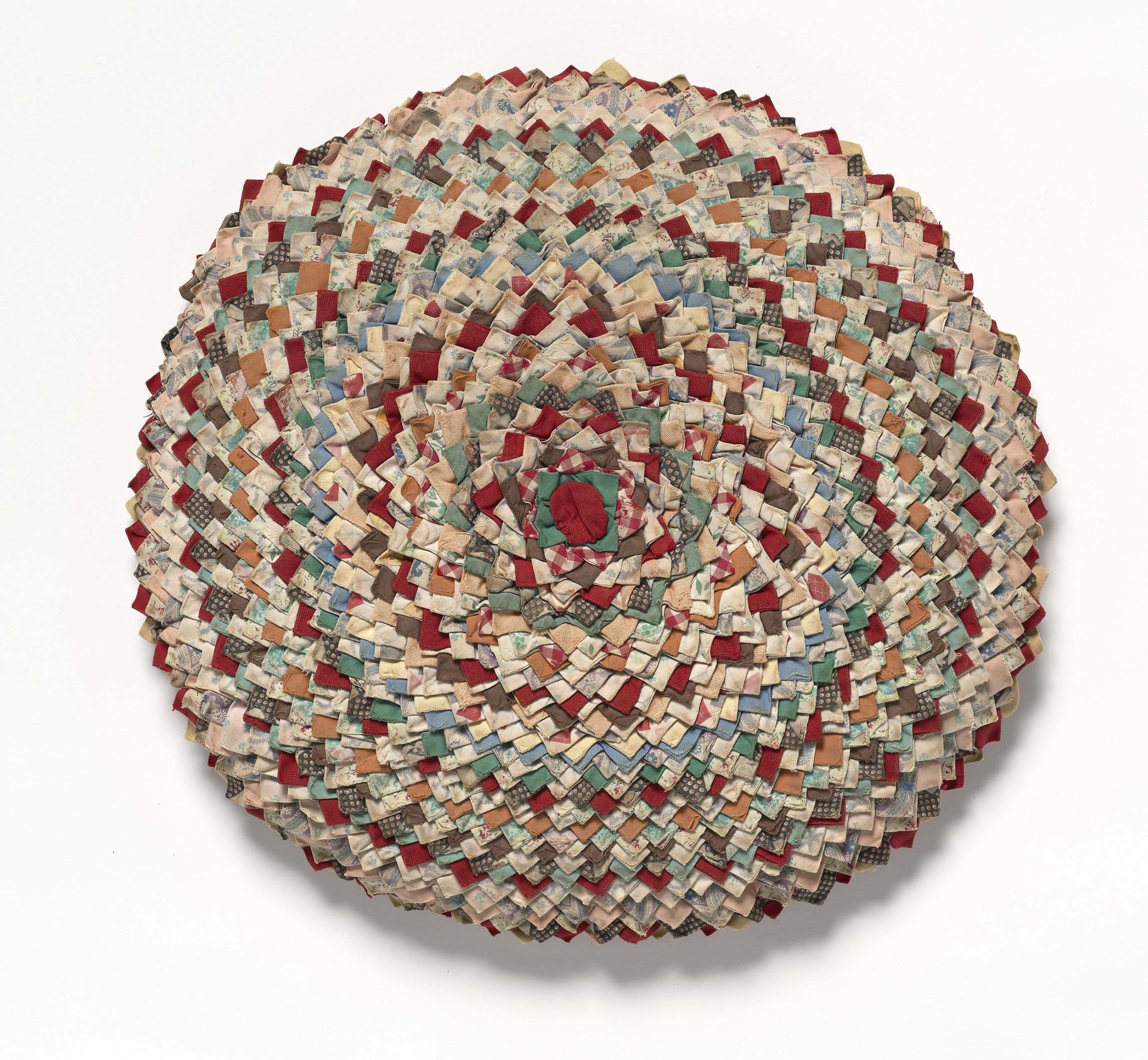
Pillow (Pine Burr pattern), by an unidentified artist in an unknown location, cotton, polyester, other blends and other synthetic fabrics, hand-pieced, 16 by 16 by 3 inches. From the Estate of Zetta M. Dempsey. Bequest of the Eli Leon Living Trust, BAMPFA, OBJ0534. Courtesy the Zetta Mae Dempsey Family. Kevin Candland photo.
Dr Elaine Y. Yau, the show’s curator and BAMPFA’s associate curator and academic liaison, explained the goals of the show more specifically to Antiques and The Arts Weekly.
“It not only aims to recognize quiltmakers of this migrant generation and quilt-keepers (those who preserve quilts, usually within descendant families) by name, but also to honor the cultural practices of commemoration, teaching, collective care and creative ingenuity that are responsible for sustaining these traditions. My hope is for visitors to the show and readers of the catalog to understand how African American quilt-making proliferated across the country…and become familiar with another chapter to the larger story of that the Gee’s Bend quiltmakers kicked off.”
She further observes that while some of the other exhibitions “draw from contemporary Black fiber artists working with an intention for exhibition and visual communication with audiences”; in the BAMPFA show, many of the earlier-made quilts “were not created with the intention of being seen in an art museum.”
“Routed West” builds on the first exhibition BAMPFA launched, in 2020, after receiving Leon’s bequest: “Rosie Lee Tompkins: A Retrospective.” A Luce Foundation grant enabled the museum to carefully receive the collection, create an inventory, provide conservation and begin the cataloging and researching process, all with the ultimate goal of a group exhibition. A series of “Quilt Study Days” seminars, funded by the Terra Foundation for American Art in 2022 and convened with a cross-disciplinary group of advisors, helped hone the project into “Routed West.”
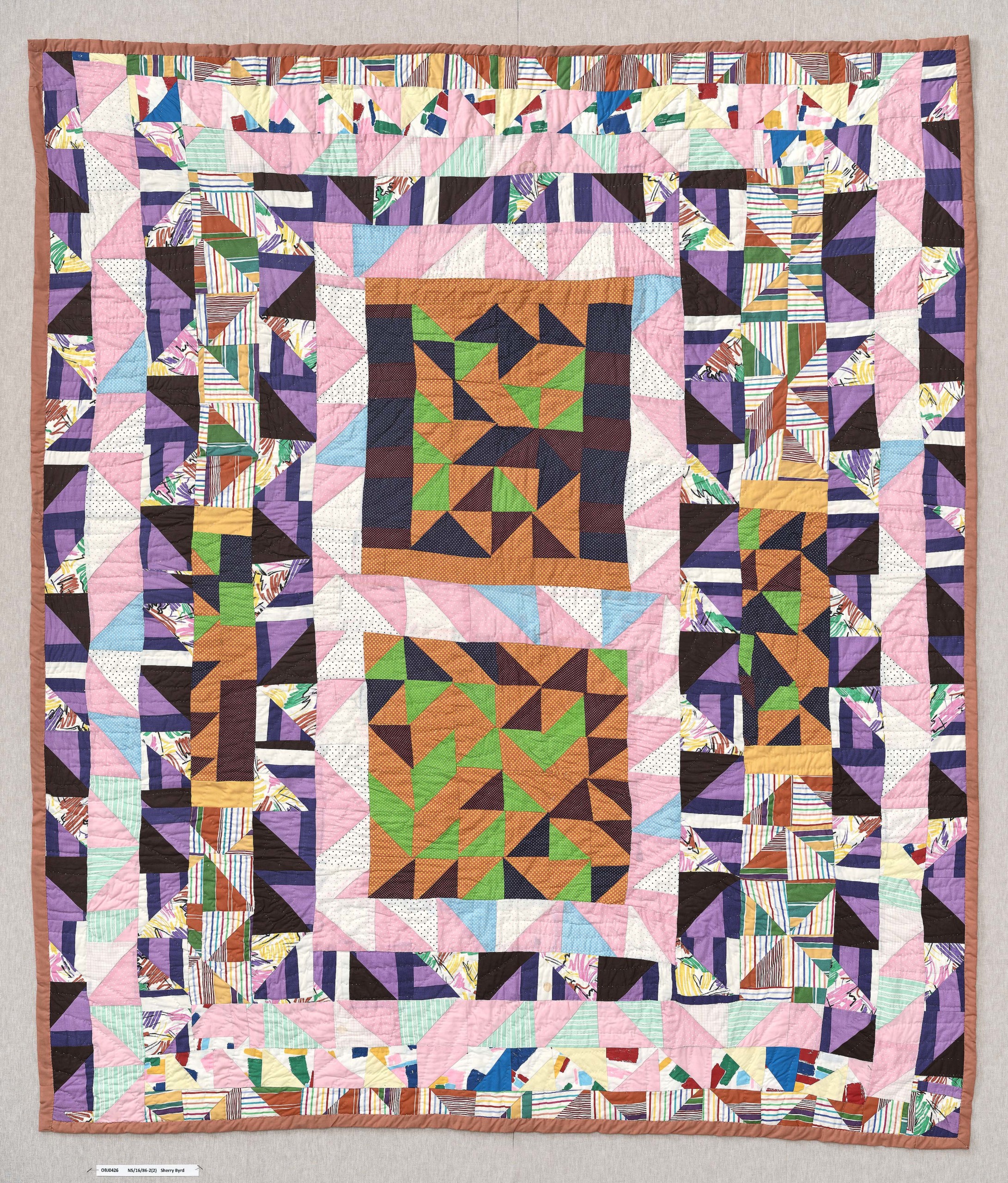
Untitled (Medallion, Broken Dishes Variation, Half-Square Triangles patterns) quilt, pieced by Bara Byrd-Stewart, Richmond, Calif., 1988, quilted by Irene Bankhead, 1989, Oakland, Calif., cotton, polyester, flannel; hand pieced, hand quilted, 62½ by 88½ inches. OBJ0853. Bequest of the Eli Leon Living Trust, BAMPFA. Courtesy Bara Byrd-Stewart. Kevin Candland photo.
In her introductory essay, Yau acknowledges the criticisms of Leon’s collecting practices and concerns over his reliance on aesthetics “over more rigorous historical research.” She calls his bequest “a tremendous archive with a complicated legacy,” appreciating his written records and interviews with quilt-makers while calling out his omission to “prioritize interviewees’ interests in their own representation… nor was he interested in centering their lives in the stories of their quilts.”
To better understand the personal, familial and communal histories embedded in the quilts themselves, Yau worked to establish dialogues with individual quilt artists and their surviving family members. Recognized to be objects of cultural heritage, the quilts are also considered vital parts in the work of affirmation, healing and collective care within African American communities; she also created new partnerships with Black quilt artists and guilds who are renewing these historical traditions in the Twenty-First Century. The role of the quilt-keeper was identified as critical to a quilt’s survival and elevated among the museum’s presentation, even included on gallery labels.
“While I was not able to reach everyone — and the outreach is on-going — the several people I was able to speak with were, for the most part, both surprised and interested in helping BAMPFA share memories and context for their ancestors’ quilts. In one case, I learned of active quilt-making within later generations of the same family, and we were able to borrow a work and display three generations of quiltmakers,” she recalled. Emphasizing this notion is Ophenia Parker’s quilt, displayed alongside quilts by her grandmother Arbie Williams and great-grandmother Francis Sheppard.
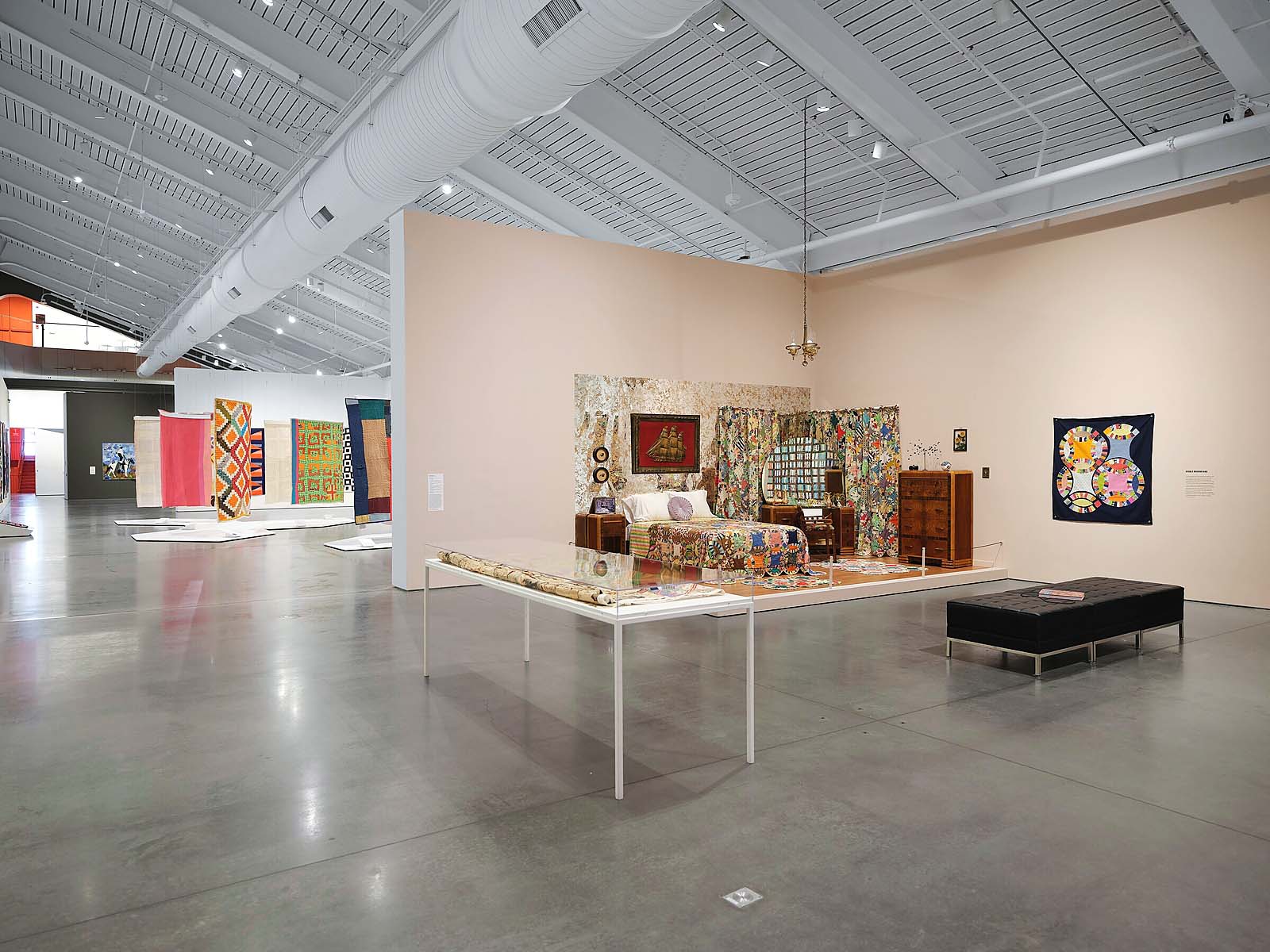
Isiadore Whitehead’s “Double Wedding Ring Room” installed in “Routed West: Twentieth Century African American Quilts in California,” Berkeley Art Museum and Pacific Film Archive, 2025. Chris Grunder photo.
Noteworthy pieces on view include Alice Neal’s “Mary Bright Commemorative Quilt,” which is considered an extraordinary tribute to the artist’s mother, who died less than a year before Neal began quilting it. Centered within it was a portrait of Mary Bright created from embroidery and a collage of fabric owned by Bright but the quilting, composition and embroidered text are a homage to her mother’s role as Neal’s first quilt teacher. Presented next to it is a quilt that contains a quilt top made by Neal’s grandmother Jane Traylor, which Neal quilted and nearly finished. Family oral history held that Traylor considered completing a quilt to be unlucky and the curator suspected that Neal followed that instinct and never fully completed the quilting, leaving behind in the quilt two needles, one threaded, the other unthreaded.
Demonstrating how one artist lived with her creations can be seen is the installation of Isiadore Whitehead’s “Double Wedding Ring Room,” which consists of a full-sized quilt, two floor mats, four drapes, and one quilted seat cover, all made in the Double Wedding Ring pattern and the original guestroom furniture and decor.
With many of the quilts having been brought by migrants from east Texas, southern Arkansas, northern Louisiana, Mississippi and east Oklahoma, the show explores some regional specificities, but the curator hopes viewers will understand the various ways of meaning the quilts carry for their keepers regardless of regional origin. “Black history is the specific cultural context, but I think everyone can relate to giving and receiving gifts, nurturing kinship ties and reflecting on how travel and movement impact one’s sense of individual and group identity,” she reflected.
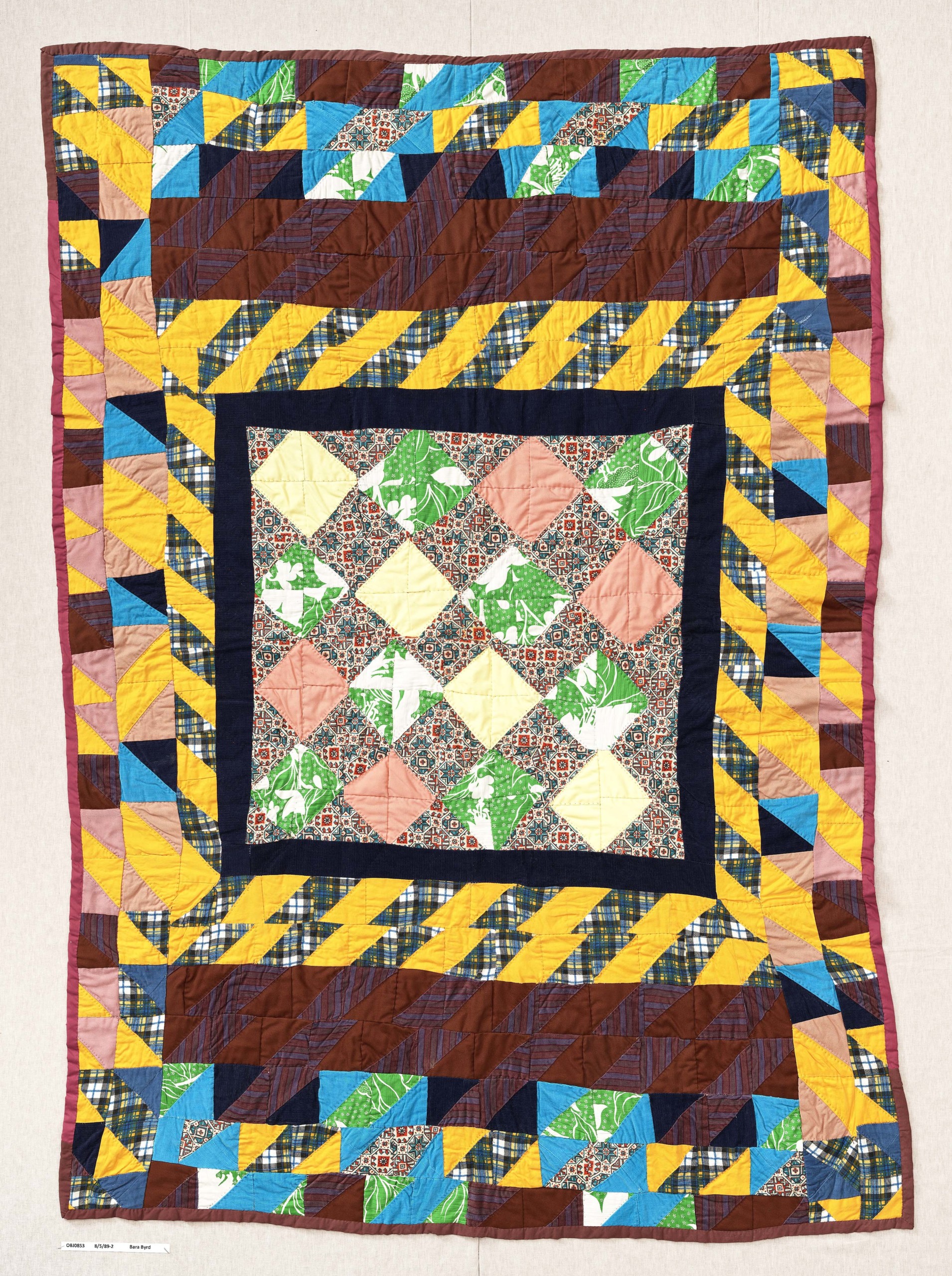
Untitled (Bars pattern) by Laverne Brackens, Fairfield, Texas, pieced 1990-91, quilted by Willia Ette Graham and Johnnie Wade, Oakland, Calif., 1992, cotton, cotton/polyester blend, polyester, velvet, other synthetic fabrics; hand and machine pieced, hand quilted, 85 by 80 inches. Bequest of the Eli Leon Living Trust, BAMPFA, OBJ3484. Courtesy Laverne Brackens. Kevin Candland photo.
“Routed West” is accompanied by an exhibition catalog, the first scholarly publication dedicated to African American quilting practices in California. In addition to Yau’s opening essay that explores the exhibition’s themes with quilt stories, Wendy Thompson writes about the Black Bay Area during the Second Great Migration. Scholar Daphne Brooks’ contribution brings the quilts in conversation with Black women’s musical performance. Contemporary studio artists Adia Millett and Basil Kincaid share personal narratives about the deep inspiration they take from African American quilting in their own art. In a transcribed roundtable conversation, Sharbreon Plummer, Carolyn Mazloomi and A’donna Richardson discuss the inequities of collecting African American quilts, while a closing essay by Bridget R. Cooks historically contextualizes Eli Leon’s collecting and proposes how art museums can redress these exclusions in the future.
“In addition to what I shared above, I would like visitors to appreciate the culture of collective care that Black migrants brought to California through quiltmaking, which contributed hugely to the social fabric of the Bay Area, and which still thrives in the hands of quiltmakers and organizations like the African American Quilt Guild of Oakland,” Yau noted in closing. “Quilt-making is a living art form and tradition that is interwoven with family and community histories — and this understanding will hopefully result in more exhibitions like ‘Routed West’ that share these stories with new audiences. I’d also love for this show to inspire people to add their quilts to history: to begin making quilts or document their quilts so that future researchers can study them. For the latter, we’ve been partnering with the African American Quilt Documentation Study Group to host afternoons in which members of the public can bring in their heirloom quilts for examination and inclusion into this national registry. We also have a quilt zine that visitors can take with them with some ideas on how they can be more quilt-minded!”
“Routed West: Twentieth Century African American Quilts in California” is on view through November 30 at the Berkeley Art Museum and Pacific Film Archive, at 2155 Center Street. For information, 510-642-0808 or www.bampfa.org.

